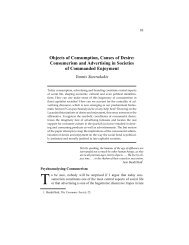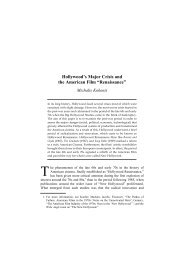19 International Symposium on Theoretical and Applied Linguistics ...
19 International Symposium on Theoretical and Applied Linguistics ...
19 International Symposium on Theoretical and Applied Linguistics ...
Create successful ePaper yourself
Turn your PDF publications into a flip-book with our unique Google optimized e-Paper software.
G E N E R A L S E S S I O N<br />
References<br />
Anastasiadi-Sime<strong>on</strong>idi, A., Ralli, A. & Chila-Markopoulou D. 2003. To genos. Patakis, Athina.<br />
Ar<strong>on</strong>off, M. <str<strong>on</strong>g>19</str<strong>on</strong>g>98. Gender agreement as morphology. In: The Proceedings of the First Mediterranean C<strong>on</strong>ference<br />
of Morphology, Eds. Booij, G., A. Ralli, S. Scalise, University of Patras. pp. 7-18<br />
Booij, G. 2005. The grammar of words: An introducti<strong>on</strong> to linguistic morphology. Oxford University Press, Oxford.<br />
Corbett, G. <str<strong>on</strong>g>19</str<strong>on</strong>g>91. Gender. CUP, Cambridge.<br />
Corbett, G. <str<strong>on</strong>g>19</str<strong>on</strong>g>98. Morphology <strong>and</strong> Agreement. In: The H<strong>and</strong>book of Morphology, A. Spencer & A. M. Zwicky eds.<br />
Blackwell, Oxford<br />
Melissaropoulou, D. & Ralli, A. 2008. Headedness in diminutive formati<strong>on</strong>: Evidence from Modern Greek <strong>and</strong> its<br />
dialectal variati<strong>on</strong>. Academiai Kiado. Acta Linguistica Hungaria – Journal Article. Vol. 55, 183-204.<br />
Ralli, A. <str<strong>on</strong>g>19</str<strong>on</strong>g>99. Gender in Greek Nouns. Proceedings of the 4th <str<strong>on</strong>g>Internati<strong>on</strong>al</str<strong>on</strong>g> C<strong>on</strong>ference <strong>on</strong> Greek <strong>Linguistics</strong>,<br />
Nicosia, Cyprus.<br />
Ritter, E. <str<strong>on</strong>g>19</str<strong>on</strong>g>93. Where’s Gender? Linguistic Inquiry, Vol. 24, 4, Fall <str<strong>on</strong>g>19</str<strong>on</strong>g>93.<br />
Roché, M. 2000. Gender inversi<strong>on</strong> in Romance derivatives with –arius.<br />
Interlanguage project: analyzing Japanese students’ pr<strong>on</strong>unciati<strong>on</strong> of English proper names<br />
1 Nilufer Misirli & 2 Elizabeth Willingham<br />
1&2 Minnesota State University<br />
1 nilufer.misirli@gmail.com & 2 eliz.willingham@gmail.com<br />
This study focuses <strong>on</strong> Japanese-to-English language transfer error as it relates to pr<strong>on</strong>unciati<strong>on</strong> of<br />
proper names. Katrin Dohlus (2005) shows that it is not uncomm<strong>on</strong> for n<strong>on</strong>-native speakers of a<br />
language to use sounds from their first language to approximate sounds in their sec<strong>on</strong>d language. Our<br />
study looks for this in the interlanguage of Japanese speakers of English. Using a four-part data<br />
collecti<strong>on</strong> tool involving a number of comm<strong>on</strong> English names, we investigated three hypotheses.<br />
Because Japanese has <strong>on</strong>ly <strong>on</strong>e liquid, we expected that our subjects would have trouble hearing <strong>and</strong><br />
pr<strong>on</strong>ouncing /l/ <strong>and</strong> /r/. On the other h<strong>and</strong>, we believed that our subjects would have an easier time<br />
saying names in which the pr<strong>on</strong>unciati<strong>on</strong> rules were similar to Japanese pr<strong>on</strong>unciati<strong>on</strong> rules – for<br />
instance, those that have a CVCV pattern or that c<strong>on</strong>tained <strong>on</strong>ly sounds found in Japanese. Our third<br />
hypothesis was that subjects would find it difficult to pr<strong>on</strong>ounce names that included c<strong>on</strong>s<strong>on</strong>ant<br />
clusters.<br />
Our three hypotheses were not universally supported. First, while our students did have difficulty<br />
with /l/ <strong>and</strong> /r/, we found that this depended <strong>on</strong> the placement of the sounds within words. Our sec<strong>on</strong>d<br />
hypothesis was somewhat supported, but our subjects’ pr<strong>on</strong>unciati<strong>on</strong>s of English names that were<br />
similar to Japanese names still sounded “foreign” because of the equal length our subjects gave to<br />
each syllable. Our research also showed that a mix of familiar <strong>and</strong> unfamiliar sounds had the highest<br />
rate of correctness – better than either close equivalents or no equivalents. This implies that it may be<br />
easier to learn completely new sounds than to retrain use of similar sounds. Our third hypothesis was<br />
supported. C<strong>on</strong>s<strong>on</strong>ant clusters were extremely difficult, even for highly proficient speakers. The<br />
hardest names had the highest number of c<strong>on</strong>s<strong>on</strong>ants per cluster. Though our hypotheses were<br />
supported to varying degrees, our analysis showed a number of factors creating a complex<br />
interlanguage system. We recognized patterns we were not looking for, including n<strong>on</strong>-reducti<strong>on</strong> of<br />
vowels, loss of diphth<strong>on</strong>gs, c<strong>on</strong>sistency of syllable length, <strong>and</strong> spelling interference. These<br />
interlanguage pr<strong>on</strong>unciati<strong>on</strong> patterns can be explained by interference from the first language, in that<br />
Japanese lacks c<strong>on</strong>s<strong>on</strong>ant clusters, gives syllables equal weight, <strong>and</strong> has <strong>on</strong>ly five vowels. The results<br />
have implicati<strong>on</strong>s for teaching.<br />
∆ιδασκαλία της νεοελληνικής γραµµατικής: έµφαση στον τύπο ή στο µήνυµα;<br />
Μία εµπειρική έρευνα.<br />
Αθανάσιος Μιχάλης<br />
Πανεπιστήµιο Αιγαίου, µέλος ΕΕΕΓ<br />
michathan@rhodes.agean.gr<br />
Πεδίο έρευνας της παρούσας εργασίας είναι η διδακτική της γραµµατικής της νεοελληνικής γλώσσας<br />
ως µητρικής στο πλαίσιο των σύγχρονων µικτών αναλυτικών προγραµµάτων σπουδών (mixed-focus<br />
curricula), µέσω της εφαρµογής των οποίων επιδιώκεται η καλλιέργεια τόσο της ευχέρειας, όσο και της<br />
ακρίβειας λόγου (accuracy). Συγκεκριµένα, η εισήγηση διερευνά το σηµαντικό ζήτηµα της µεθόδου<br />
διδασκαλίας των µορφοσυντακτικών δοµών και κανόνων, εστιάζοντας στο «δίληµµα»: µορφοκεντρικού<br />
τύπου διδασκαλία µε έµφαση στους γλωσσικούς τύπους και κανόνες (focus <strong>on</strong> forms) ή αβίαστη<br />
<str<strong>on</strong>g>19</str<strong>on</strong>g> th ISTAL 37






